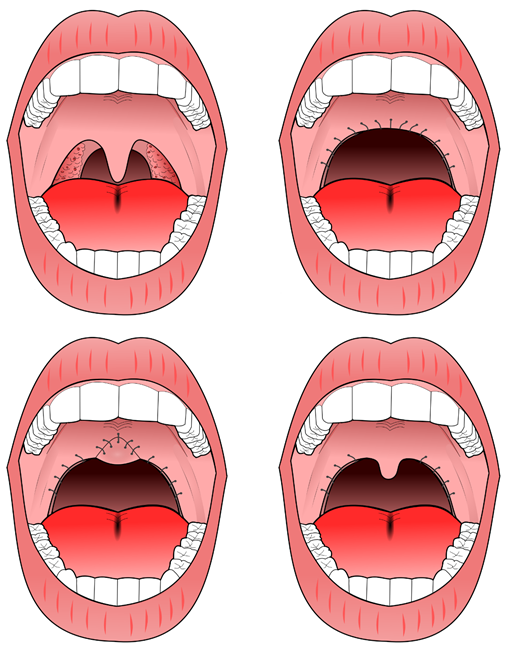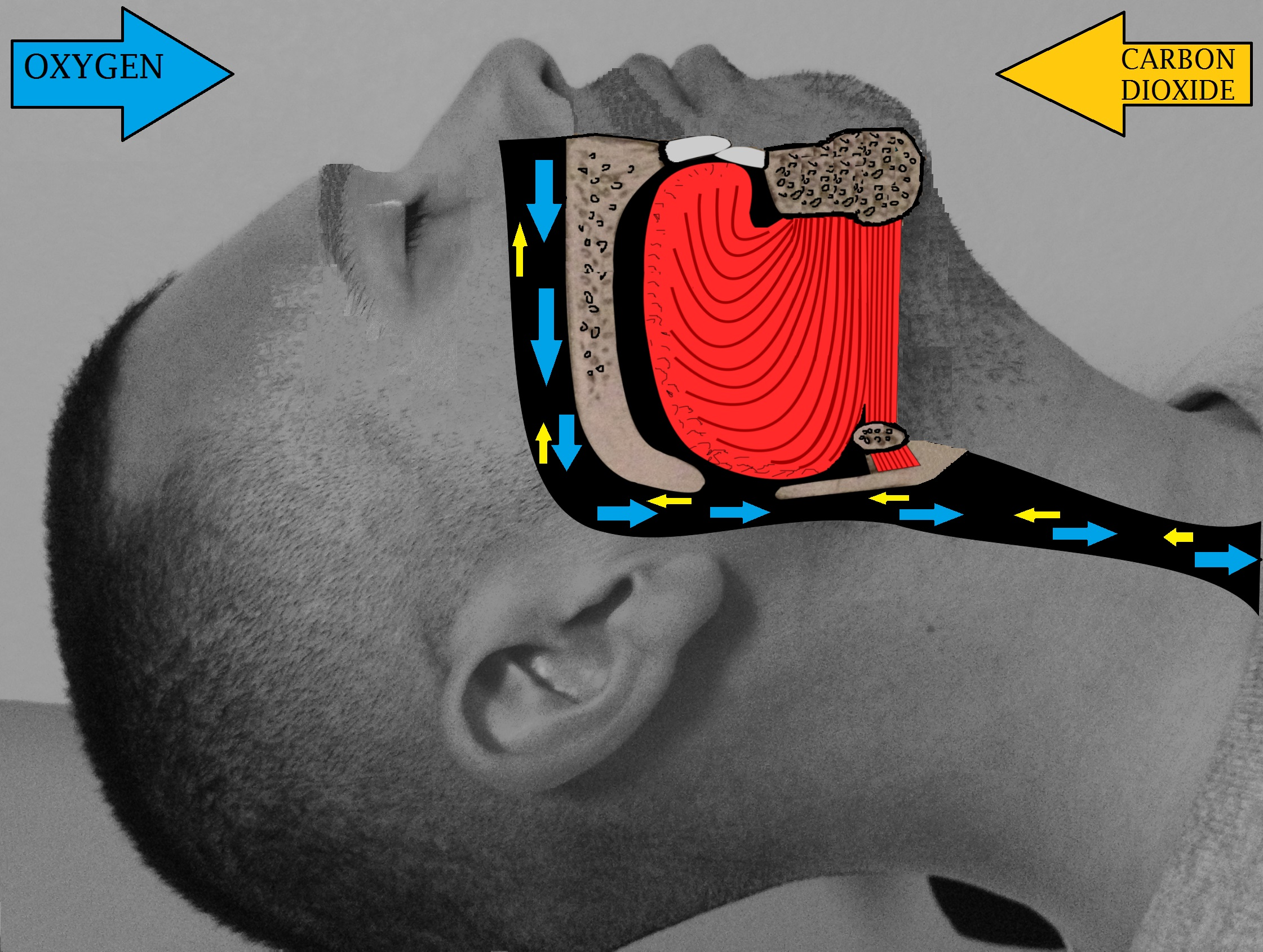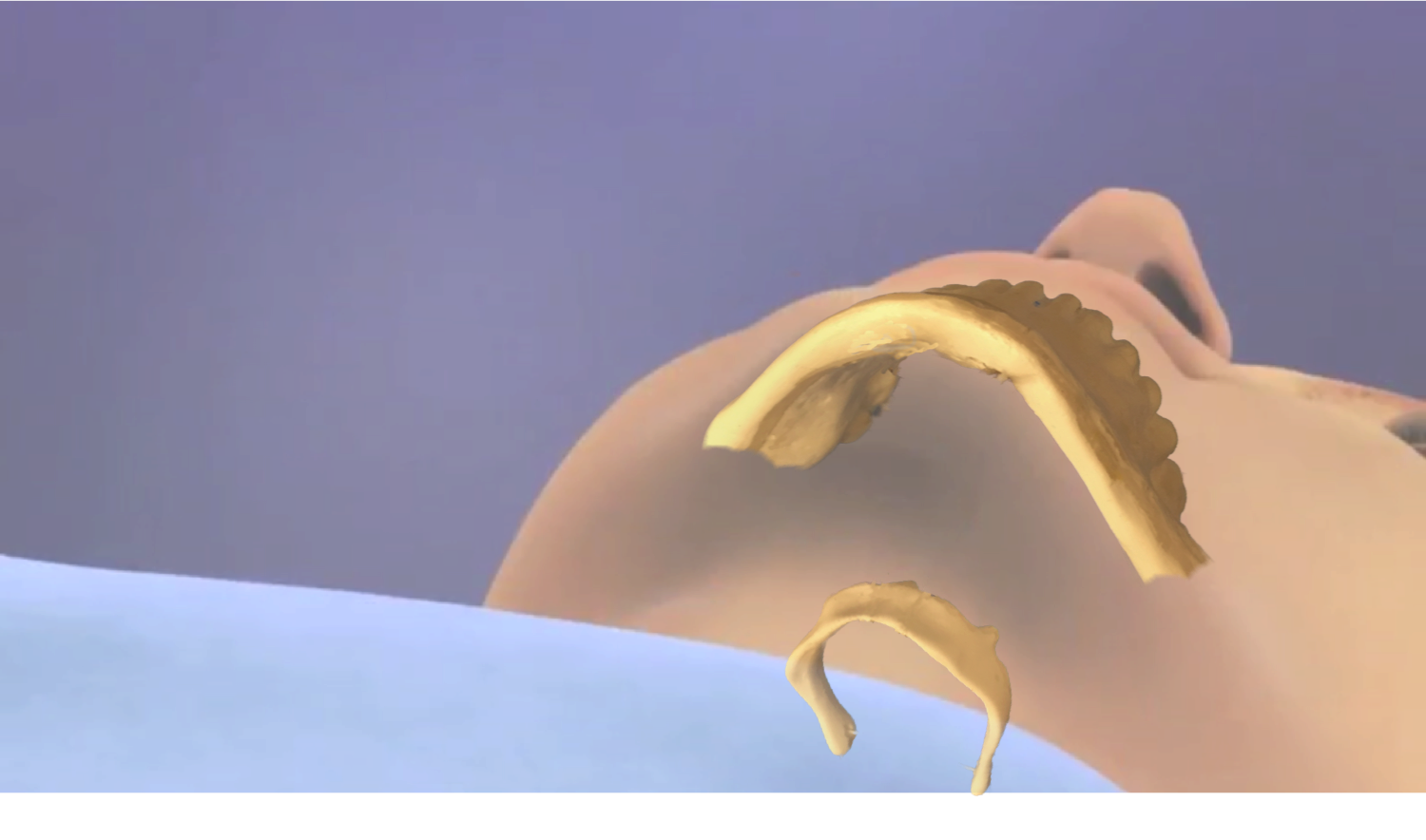|
Uvulopalatopharyngoplasty
Uvulopalatopharyngoplasty (also known by the abbreviations UPPP and UP3) is a surgical procedure or sleep surgery used to remove tissue and/or remodel tissue in the throat. This could be because of sleep issues. Tissues which may typically be removed include: * The tonsils * The adenoids Tissues which may typically be remodeled include: * The uvula (see uvulotomy) * The soft palate * The pharynx Procedure UPPP involves removal of the tonsils, the posterior surface of the soft palate, and the uvula. The uvula is then folded toward the soft palate and sutured together as demonstrated in the figures. In the US, UPPP is the most commonly performed procedure for obstructive sleep apnea with approximately 33,000 procedures performed per year. The surgery is more successful in patients who are not obese, and there is a limited role in morbidly obese (>40 kg/m2) individuals. Procedural details Standard procedure UPPP is typically administered to patients with obstructive s ... [...More Info...] [...Related Items...] OR: [Wikipedia] [Google] [Baidu] |
Sleep Surgery
Sleep surgery is a surgery performed to treat sleep disordered breathing. Sleep disordered breathing is a spectrum of disorders that includes snoring, upper airway resistance syndrome, and obstructive sleep apnea. These surgeries are performed by surgeons trained in otolaryngology, oral maxillofacial surgery, and craniofacial surgery. Definitions Obstructive sleep apnea or sleep apnea is defined as either cessation of breathing (apnea) for 10 seconds, or a decrease in normal breathing (hypopnea) with an associated desaturation in oxygen and arousal during sleep that lasts at least 10 seconds. In adults, it is typical to have up to 4.9 events per hour. In obstructive sleep apnea, affected individuals are categorized based on how many apneas or hypopneas ( apnea-hypopnea index or AHI) or events they have per hour. * Normal: <5 events per hour * Mild: 5 to <15 events per hour * Moderate: 15 to 30 events per hour * Severe: >30 events per hour The Wisconsin Sleep Cohort Study, a [...More Info...] [...Related Items...] OR: [Wikipedia] [Google] [Baidu] |
Sleep Surgery
Sleep surgery is a surgery performed to treat sleep disordered breathing. Sleep disordered breathing is a spectrum of disorders that includes snoring, upper airway resistance syndrome, and obstructive sleep apnea. These surgeries are performed by surgeons trained in otolaryngology, oral maxillofacial surgery, and craniofacial surgery. Definitions Obstructive sleep apnea or sleep apnea is defined as either cessation of breathing (apnea) for 10 seconds, or a decrease in normal breathing (hypopnea) with an associated desaturation in oxygen and arousal during sleep that lasts at least 10 seconds. In adults, it is typical to have up to 4.9 events per hour. In obstructive sleep apnea, affected individuals are categorized based on how many apneas or hypopneas ( apnea-hypopnea index or AHI) or events they have per hour. * Normal: <5 events per hour * Mild: 5 to <15 events per hour * Moderate: 15 to 30 events per hour * Severe: >30 events per hour The Wisconsin Sleep Cohort Study, a [...More Info...] [...Related Items...] OR: [Wikipedia] [Google] [Baidu] |
Hyoid Suspension
Hyoid suspension, also known as hyoid myotomy and suspension or hyoid advancement, is a surgical procedure or sleep surgery in which the hyoid bone and its muscle attachments to the tongue and airway are pulled forward with the aim of increasing airway size and improving airway stability in the retrolingual and hypopharyngeal airway (airway behind and below the base of tongue). The horseshoe shaped hyoid bone sits directly below the base of tongue with the arms of the bone flanking the airway. Hyoid suspension is typically performed as a treatment for obstructive sleep apnea (OSA). This procedure is frequently performed with a uvulopalatopharyngoplasty (UPPP) which targets sites of obstruction higher in the airway. Typically, a hyoid suspension is considered successful when the patient's apnea-hypopnea index is significantly reduced after surgery. Background The American Academy of Otolaryngology–Head and Neck Surgery position statement considers hyoid suspension "effective and ... [...More Info...] [...Related Items...] OR: [Wikipedia] [Google] [Baidu] |
Tonsillectomy
Tonsillectomy is a surgical procedure in which both palatine tonsils are fully removed from the back of the throat. The procedure is mainly performed for recurrent tonsillitis, throat infections and obstructive sleep apnea (OSA). For those with frequent throat infections, surgery results in 0.6 (95% confidence interval: 1.0 to 0.1) fewer sore throats in the following year, but there is no evidence of long term benefits. In children with OSA it results in improved quality of life. While generally safe, complications may include bleeding, vomiting, dehydration, trouble eating, and trouble talking. Throat pain typically lasts about one to two weeks after surgery. Bleeding occurs in about 1% within the first day and another 2% after that. Death occurs as a result in between 1 out of 2,360 and 1 in 56,000 procedures. Tonsillectomy does not appear to affect long term immune function. Following the surgery ibuprofen and paracetamol (acetaminophen) may be used to treat postoperative ... [...More Info...] [...Related Items...] OR: [Wikipedia] [Google] [Baidu] |
Uvula
The palatine uvula, usually referred to as simply the uvula, is a conic projection from the back edge of the middle of the soft palate, composed of connective tissue containing a number of racemose glands, and some muscular fibers. It also contains many serous glands, which produce thin saliva. It is only found in human beings. Structure Muscle The muscular part of the uvula () shortens and broadens the uvula. This changes the contour of the posterior part of the soft palate. This change in contour allows the soft palate to adapt closely to the posterior pharyngeal wall to help close the nasopharynx during swallowing. Its muscles are controlled by the pharyngeal branch of the vagus nerve. Variation A bifid or bifurcated uvula is a split or cleft uvula. Newborns with cleft palate often also have a split uvula. The bifid uvula results from incomplete fusion of the palatine shelves but it is considered only a slight form of clefting. Bifid uvulas have less muscle in th ... [...More Info...] [...Related Items...] OR: [Wikipedia] [Google] [Baidu] |
Uvulotomy
A uvulotomy or staphylotomy is any cutting operation performed on the uvula. The procedure was performed in European medieval medicine. The Norwegian Eiríkr Hákonarson bled to death following such an operation. Uvulotomy is employed in folk medicine in Tigray. In the 19th century uvulotomy came to be used as a treatment for snoring.Oommen 1988, p. 18. See uvulopalatopharyngoplasty Uvulopalatopharyngoplasty (also known by the abbreviations UPPP and UP3) is a surgical procedure or sleep surgery used to remove tissue and/or remodel tissue in the throat. This could be because of sleep issues. Tissues which may typically be remov .... Its CPT 2009 code is "42140, Uvulectomy". References * Finlay, Alison (editor and translator) (2004). ''Fagrskinna, a Catalogue of the Kings of Norway''. Brill Academic Publishers. * Mathew, Oommen P. et al. (1988). ''Respiratory Function of the Upper Airway. Marcel Dekker. UvulotomyBiology Online entry EthnoMed article {{Procedures on the mou ... [...More Info...] [...Related Items...] OR: [Wikipedia] [Google] [Baidu] |
Genioglossus Advancement
Genioglossus advancement (GA), also known as genial tubercle advancement (GTA), is a surgical procedure or sleep surgery in which the base of the tongue The tongue is a muscular organ in the mouth of a typical tetrapod. It manipulates food for mastication and swallowing as part of the digestive process, and is the primary organ of taste. The tongue's upper surface (dorsum) is covered by taste bu ... is pulled forward, usually to increase airway size due to deformity or a sleep breathing disorder. This procedure is frequently performed with either uvulopalatopharyngoplasty or maxillomandibular advancement surgeries. Tongue muscles (genioglossus, geniohyoid and others) are attached to the lower jaw below the teeth. During a genioglossus advancement procedure, a small window or bone cut is made in the front part of the lower jaw (mandible) at the level of the geniotubercle which is where the genioglossus muscle is attached. This piece of bone along with the attachment for th ... [...More Info...] [...Related Items...] OR: [Wikipedia] [Google] [Baidu] |
Sleep Apnea
Sleep apnea, also spelled sleep apnoea, is a sleep disorder in which pauses in breathing or periods of shallow breathing during sleep occur more often than normal. Each pause can last for a few seconds to a few minutes and they happen many times a night. In the most common form, this follows loud snoring. There may be a choking or snorting sound as breathing resumes. Because the disorder disrupts normal sleep, those affected may experience sleepiness or feel tired during the day. In children, it may cause hyperactivity or problems in school. Sleep apnea may be either obstructive sleep apnea (OSA), in which breathing is interrupted by a blockage of air flow, central sleep apnea (CSA), in which regular unconscious breath simply stops, or a combination of the two. OSA is the most common form. OSA has four key contributors; these include a narrow, crowded, or collapsible upper airway, an ineffective pharyngeal dilator muscle function during sleep, airway narrowing during sleep a ... [...More Info...] [...Related Items...] OR: [Wikipedia] [Google] [Baidu] |
Maxillomandibular Advancement
Maxillomandibular advancement (MMA) or orthognathic surgery, also sometimes called bimaxillary advancement (Bi-Max), or maxillomandibular osteotomy (MMO), is a surgical procedure or sleep surgery which moves the upper jaw (maxilla) and the lower jaw (mandible) forward. The procedure was first used to correct deformities of the facial skeleton to include malocclusion. In the late 1970s advancement of the lower jaw (mandibular advancement) was noted to improve sleepiness in three patients. Subsequently, maxillomandibular advancement was used for patients with obstructive sleep apnea. Currently, maxillomandibular advancement surgery is often performed simultaneously with genioglossus advancement (tongue advancement). The genioglossus advancement pulls the tongue forward in a manner that decreases the amount of tongue blockage during sleep. MMA has been demonstrated to be one of the most effective surgical treatments for sleep apnea, due to its high success rate. Nonetheless, the p ... [...More Info...] [...Related Items...] OR: [Wikipedia] [Google] [Baidu] |
Uvular Consonant
Uvulars are consonants articulated with the back of the tongue against or near the uvula, that is, further back in the mouth than velar consonants. Uvulars may be stops, fricatives, nasals, trills, or approximants, though the IPA does not provide a separate symbol for the approximant, and the symbol for the voiced fricative is used instead. Uvular affricates can certainly be made but are rare: they occur in some southern High-German dialects, as well as in a few African and Native American languages. (Ejective uvular affricates occur as realizations of uvular stops in Lillooet, Kazakh, or as allophonic realizations of the ejective uvular fricative in Georgian.) Uvular consonants are typically incompatible with advanced tongue root, and they often cause retraction of neighboring vowels. Uvular consonants in IPA The uvular consonants identified by the International Phonetic Alphabet are: , being/existence , - !χʼ , uvular ejective fricative , Tlingit , x̱'aan , '' ... [...More Info...] [...Related Items...] OR: [Wikipedia] [Google] [Baidu] |
Tongue
The tongue is a muscular organ in the mouth of a typical tetrapod. It manipulates food for mastication and swallowing as part of the digestive process, and is the primary organ of taste. The tongue's upper surface (dorsum) is covered by taste buds housed in numerous lingual papillae. It is sensitive and kept moist by saliva and is richly supplied with nerves and blood vessels. The tongue also serves as a natural means of cleaning the teeth. A major function of the tongue is the enabling of speech in humans and vocalization in other animals. The human tongue is divided into two parts, an oral part at the front and a pharyngeal part at the back. The left and right sides are also separated along most of its length by a vertical section of fibrous tissue (the lingual septum) that results in a groove, the median sulcus, on the tongue's surface. There are two groups of muscles of the tongue. The four intrinsic muscles alter the shape of the tongue and are not attached to bone. The f ... [...More Info...] [...Related Items...] OR: [Wikipedia] [Google] [Baidu] |
Nasal Cavity
The nasal cavity is a large, air-filled space above and behind the nose in the middle of the face. The nasal septum divides the cavity into two cavities, also known as fossae. Each cavity is the continuation of one of the two nostrils. The nasal cavity is the uppermost part of the respiratory system and provides the nasal passage for inhaled air from the nostrils to the nasopharynx and rest of the respiratory tract. The paranasal sinuses surround and drain into the nasal cavity. Structure The term "nasal cavity" can refer to each of the two cavities of the nose, or to the two sides combined. The lateral wall of each nasal cavity mainly consists of the maxilla. However, there is a deficiency that is compensated for by the perpendicular plate of the palatine bone, the medial pterygoid plate, the labyrinth of ethmoid and the inferior concha. The paranasal sinuses are connected to the nasal cavity through small orifices called ostia. Most of these ostia communicate with ... [...More Info...] [...Related Items...] OR: [Wikipedia] [Google] [Baidu] |







